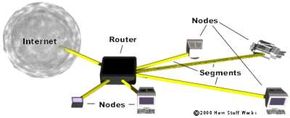Networking Basics
Here are some of the fundamental parts of a network:
- Network - A network is a group of computers connected together in a way that allows information to be exchanged between the computers.
- Node - A node is anything that is connected to the network. While a node is typically a computer, it can also be something like a printer or CD-ROM tower.
- Segment - A segment is any portion of a network that is separated, by a switch, bridge or router, from other parts of the network.
- Backbone - The backbone is the main cabling of a network that all of the segments connect to. Typically, the backbone is capable of carrying more information than the individual segments. For example, each segment may have a transfer rate of 10 Mbps (megabits per second), while the backbone may operate at 100 Mbps.
- Topology - Topology is the way that each node is physically connected to the network (more on this in the next section).
- Local Area Network (LAN) - A LAN is a network of computers that are in the same general physical location, usually within a building or a campus. If the computers are far apart (such as across town or in different cities), then a Wide Area Network (WAN) is typically used.
- Network Interface Card (NIC) - Every computer (and most other devices) is connected to a network through an NIC. In most desktop computers, this is an Ethernet card (normally 10 or 100 Mbps) that is plugged into a slot on the computer's motherboard.
- Media Access Control (MAC) address - This is the physical address of any device -- such as the NIC in a computer -- on the network. The MAC address, which is made up of two equal parts, is 6 bytes long. The first 3 bytes identify the company that made the NIC. The second 3 bytes are the serial number of the NIC itself.
- Unicast - A unicast is a transmission from one node addressed specifically to another node.
- Multicast - In a multicast, a node sends a packet addressed to a special group address. Devices that are interested in this group register to receive packets addressed to the group. An example might be a Cisco router sending out an update to all of the other Cisco routers.
- Broadcast - In a broadcast, a node sends out a packet that is intended for transmission to all other nodes on the network.
On the next page, we'll discuss some of the most common network topologies.
Advertisement
